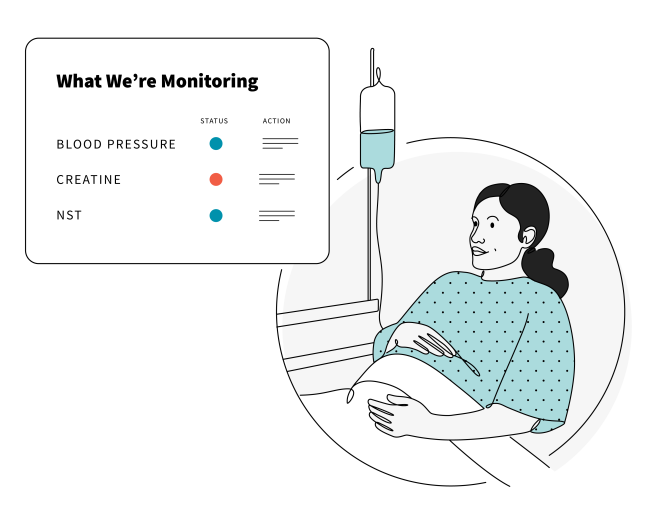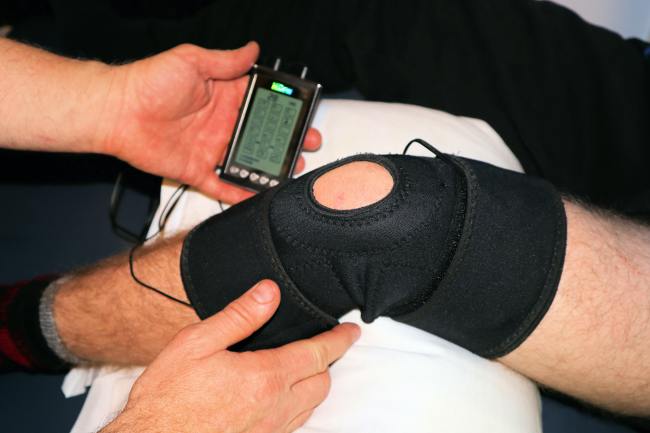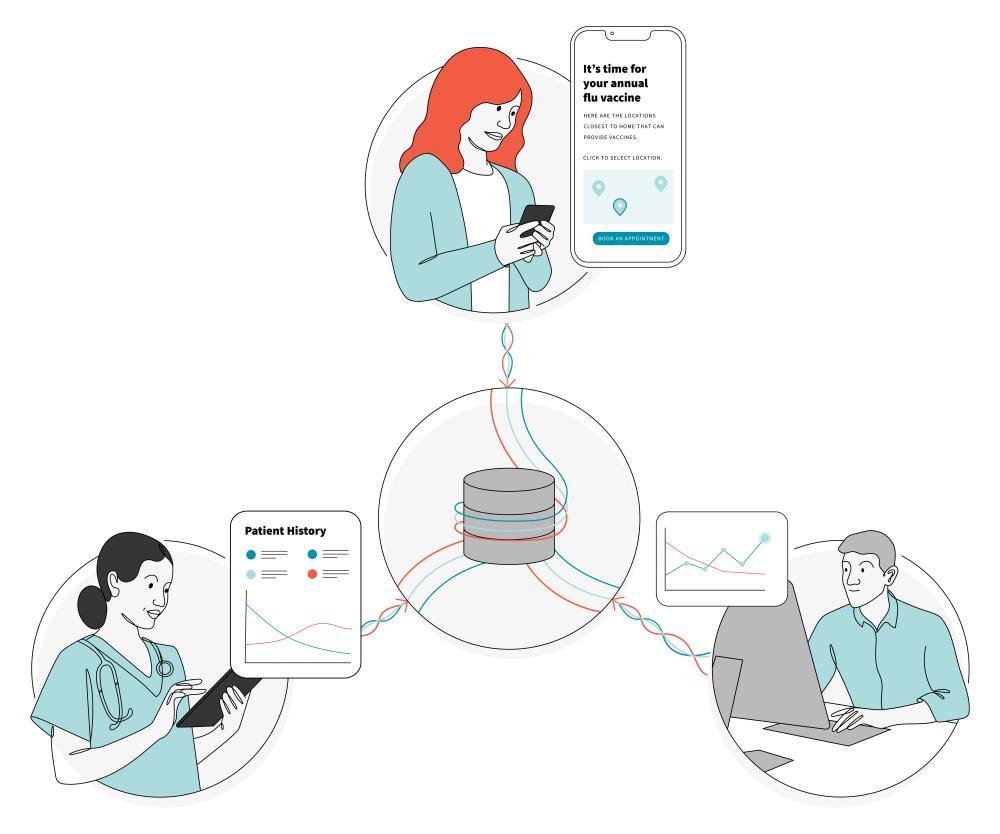
What does a flu shot have in common with a heart attack? Not much. But you’d never know it judging by the design of our healthcare system, which treats preventative, acute, and every other form of care the same from a payment perspective.
Healthcare resources are leveraged in ways that revolve around fee-for-service reimbursement models, which tend to work directly against the main objectives of a healthy system: to improve outcomes, enhance the experience of care for providers and patients, and lower costs.
Sadly, our current system is mostly failing to live up to these goals. Digital investments such as electronic health records (EHRs) and patient-facing technologies such as patient portals have not lived up to their promised potential in improving efficiencies and experience. Additionally, nurses and doctors are facing increasing burnout, due to understaffing and continual paperwork.
We need a redesign. To improve healthcare, our delivery systems must be explicitly designed around the four types of care we receive (elective, acute, preventative, and chronic) and their goals. From there, we can appropriately allocate resources and design a cohesive experience. We must re-think the business model for each type of care. While who pays is a political question, the business model is a design question—and, we hasten to add, this design must take place at the earliest possible stages and involve organizational partnership at the leadership level. This post suggests a new vision of care.
PREVENTATIVE CARE
Preventative care focuses on services designed to prevent disease and maintain health, such as annual blood work and cancer screenings. The completion of these services, while important, tends to not be urgent but should be done at a specific cadence. For providers, preventative care is resource-intensive. While seeing a patient for a few minutes annually may not seem like a lot, these minutes compound over the year, taking providers away from more urgent forms of care.
Preventative care is sort of like ongoing vehicle maintenance for your car, comparable to an oil change. You know you need to do it regularly and you know when (every 5,000 miles or so), but there’s wiggle room around when it can be done, and you don’t need a specialist to take care of it. The Jiffy Lubes of the world work just fine (or you can do it yourself).
Preventative care could be much less resource intensive for providers than it is today. Most preventative care doesn’t require any sort of clinician. Not only can most instances be handled by technicians, phlebotomists, or even yourself, the location does not necessarily need to be a clinical setting. Locations can range from your home to a retail pharmacy, and technology can ensure compliance and flag anything that needs to be escalated to a healthcare provider.
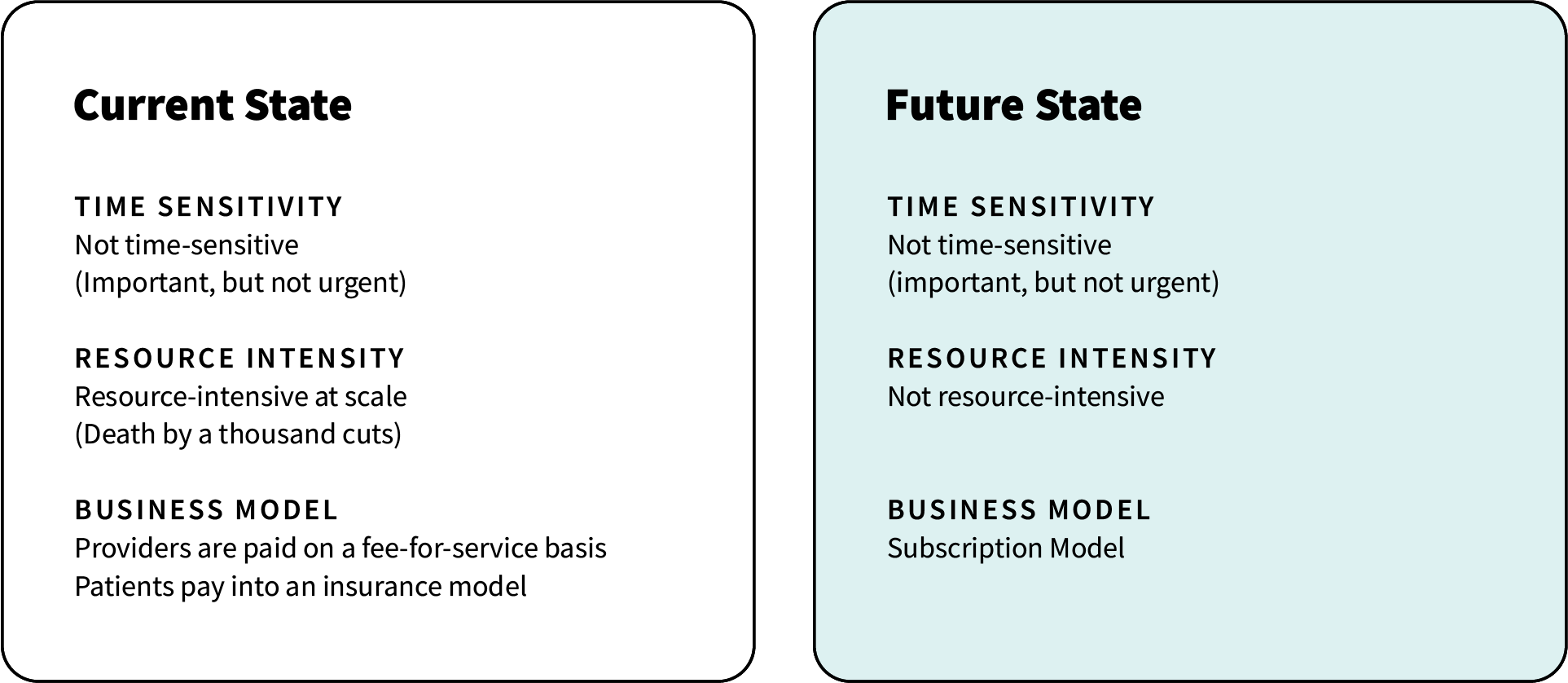
How to improve the experience? We suggest creating a proactive and personalized digital experience optimizing patient data, home delivery for preventative care services (which expands on what already exists), and utilizing prevalent and/or public spaces (such as pop-ups or retail pharmacy) for shots and vitals.

The current business model for preventative care doesn’t make much sense. Patients pay into an insurance model, despite knowing they can and should use these services. This is compounded by Flexible Spending Accounts (FSAs), where patients are setting aside money for care they know they will receive. What if the preventative care business model looked more like Netflix? With a subscription, consumers have access to a suite of services, and are encouraged to utilize all of them, much like Netflix loves when you binge-watch. While on the outside this might not look different to patients today, it’s a reframing of where and how the money is spent.
ELECTIVE CARE
Elective care is non-essential medical care, like plastic surgery or Lasik. With elective care there is a lack of time sensitivity, which enables patients to shop around, leading to patient choice in the type and cost of services they are offered from providers.
Back to your car. Let’s say you want to repaint it a new color. Auto insurance doesn’t cover cosmetic changes, so you’d need to pay for a refresh out of pocket. Likewise, health insurance generally does not cover elective care, so patients and/or employers fill in the gaps themselves.
Unlike other types of care patients receive, the current system works relatively well for elective services. Since patients can shop around and the free market is at play, the cost of these procedures has gone down over time. For example, the average cost of Lasik has remained relatively the same for the last 25 years, despite inflation.
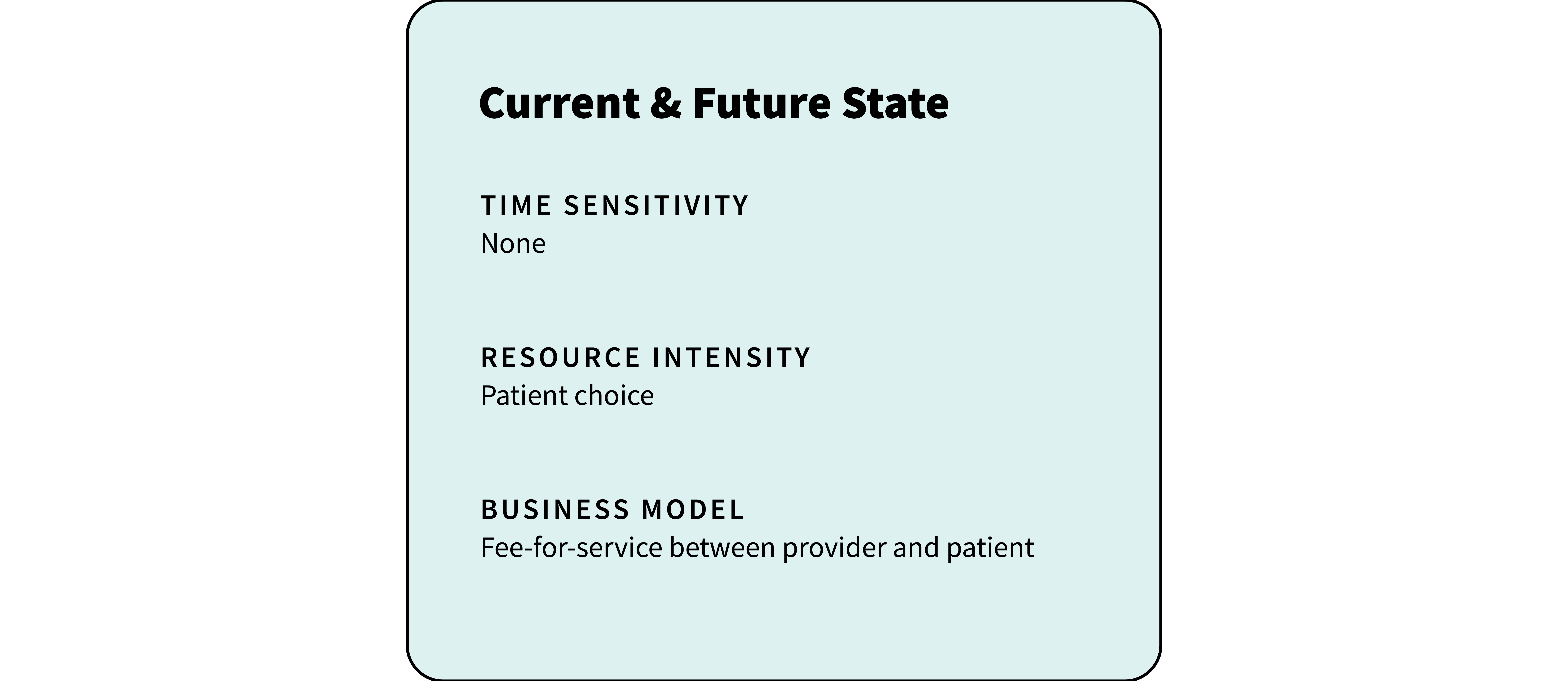
ACUTE CARE
Acute care is medical care for a short-term or severe illness/event of a relatively brief period of time. Examples of this range from strep-throat, to an injury, such as a broken wrist, to a heart attack. This type of care is intentionally time- and resource-intensive.
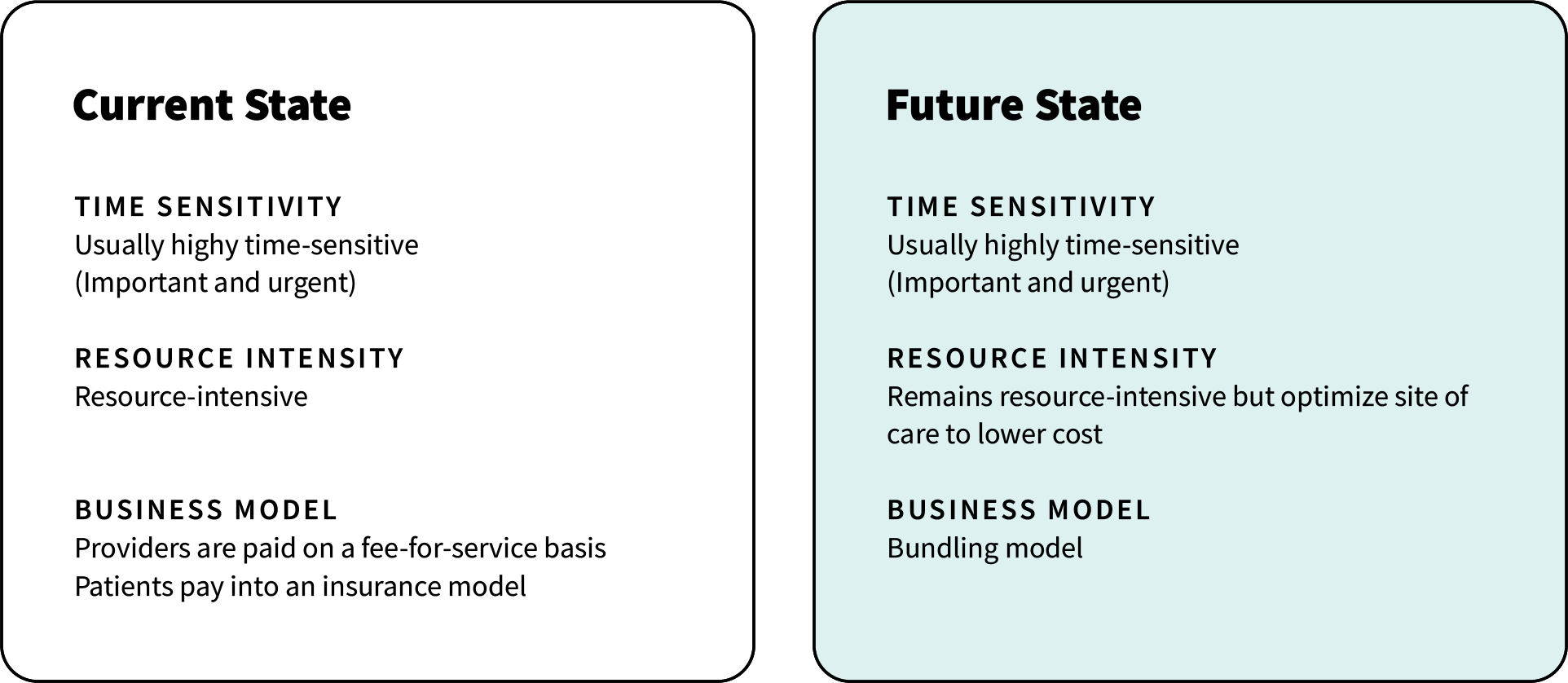
While existing acute care generally meets a need within the healthcare market, the most obvious area for improvement is reducing unnecessary ER visits. Currently, hospitals don’t have a good mechanism for routing patients to the right location of care based on their given issue. Patients want to avoid the ER; it’s extremely slow and in a post-Covid world, patients want to avoid other sick people. Pre-visit triage has been done in certain areas with success. For example, urgent care locations divert patients from the ER, and pediatric hotlines help new parents determine if they should bring their child into the ER. These models should be incentivized and expanded.

A commonly used business model that could be utilized more widely for acute care is the bundling model. Bundling is a set price for a given episode of care. The provider assumes the risk associated with cost overruns related to care during that episode, but also is rewarded financially for low-cost, efficient care delivery. This model has already been shown to deliver value in a range of care episodes, from joint replacements to cardiac surgeries.
CHRONIC CARE
Chronic care aims to address pre-existing or long-term illnesses, ranging from diabetes to hypertension. Chronic care tends to fall into two categories: (1) monitoring; and (2) discrete episodes. During monitoring, the condition is stable but in the background, there are ongoing checks to detect for any changes that may occur. During a discrete episode, the condition isn’t stable and requires additional interventions. Currently, both forms of chronic care tend to be resource-intensive because of the one-size-fits-all approach to chronic care management and payment.
Chronic care must recognize that bifurcation. For example, during a hypertension episode, the patient’s provider is following an algorithm (JNC-9) based on the success or failure of previous medication(s) in lowering the patient’s blood pressure. Once their blood pressure is controlled, the patient can progress to monitoring. During an episode, the model mirrors acute care, with time-sensitivity and more required resources from the provider. However, during monitoring, it should mirror preventative care. This is less time-sensitive and should not require a large number of resources from the provider.

The current business model for providers tends to be a fee-for-service model, which doesn’t align incentives. The business model for chronic care also needs to “toggle.” For monitoring, a value-based care model is predictive and aligns incentives. This enables providers to be rewarded for when their patients are healthy, and by having the interactions be more low-touch, they can take on more patients and increase revenue. However, when there is an episode, a bundling model, similar to acute care, needs to be implemented. This will ensure that providers are fairly compensated for unforeseen events.
BRINGING IT ALL TOGETHER
By understanding the different types of care needs, we can better map the care types to time-sensitivity and resource-intensity. Seeing these mapped together shows how the different types of care relate and differentiate from one another.
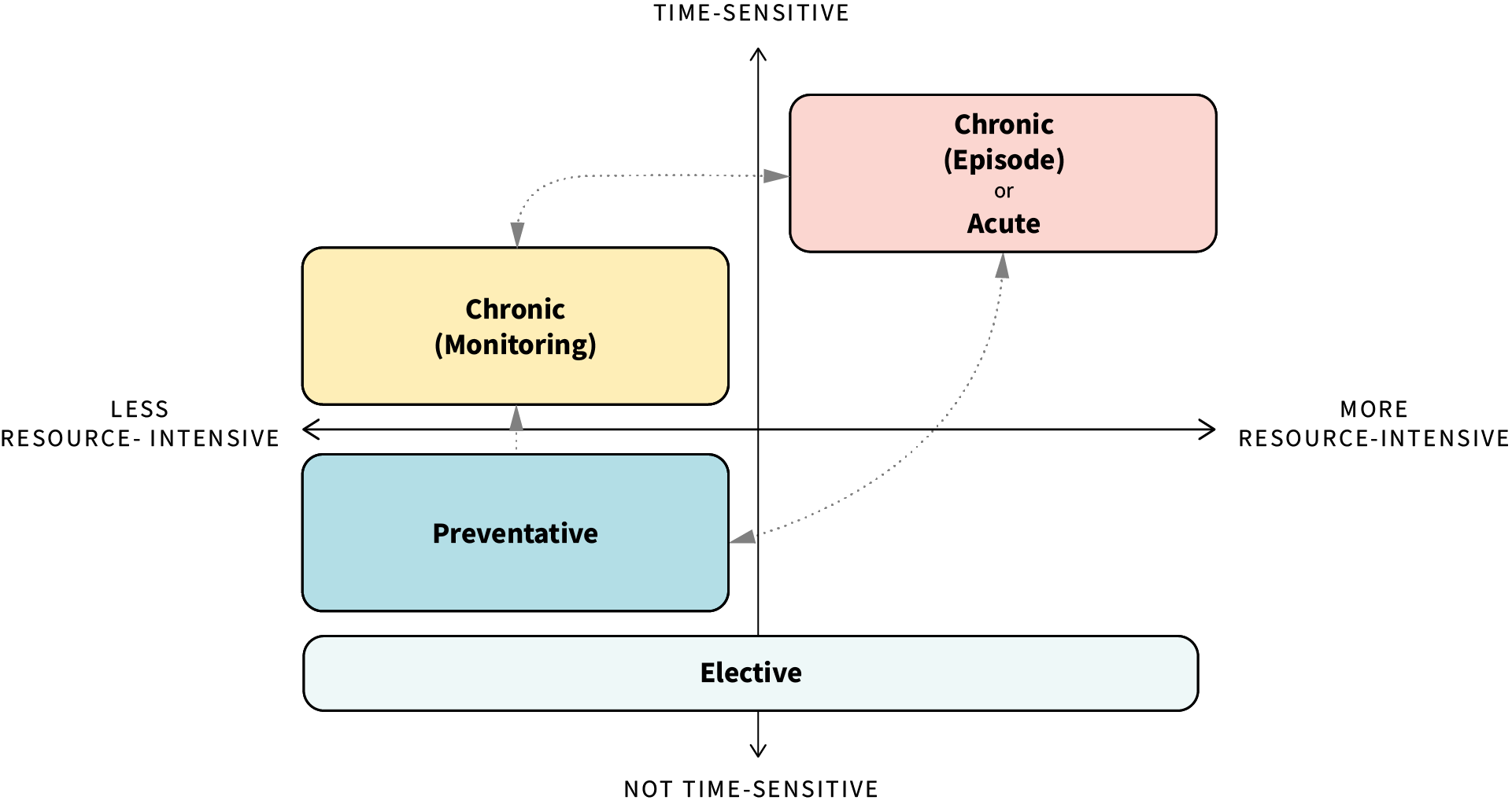
MAKING IT REAL
In order to explicitly design around the four types of care outlined, the technology driving it must be reimagined. Today’s patient-facing technologies tend to revolve around a static email (the patient portal) or a disease-specific application that is not specific to the patient. This creates a fragmented and confusing patient experience, especially for those patients with multiple, chronic diseases. Additionally, the biggest tool in a provider's hands, the EHR, is focused on billing, not care. The EHR was never designed to interface with patients, which is what it is being forced to do now.
Owners of digital health ecosystems need to embrace a middleware or abstraction layer that sits between patient-facing technology and related clinical workflows in the EHR solves.
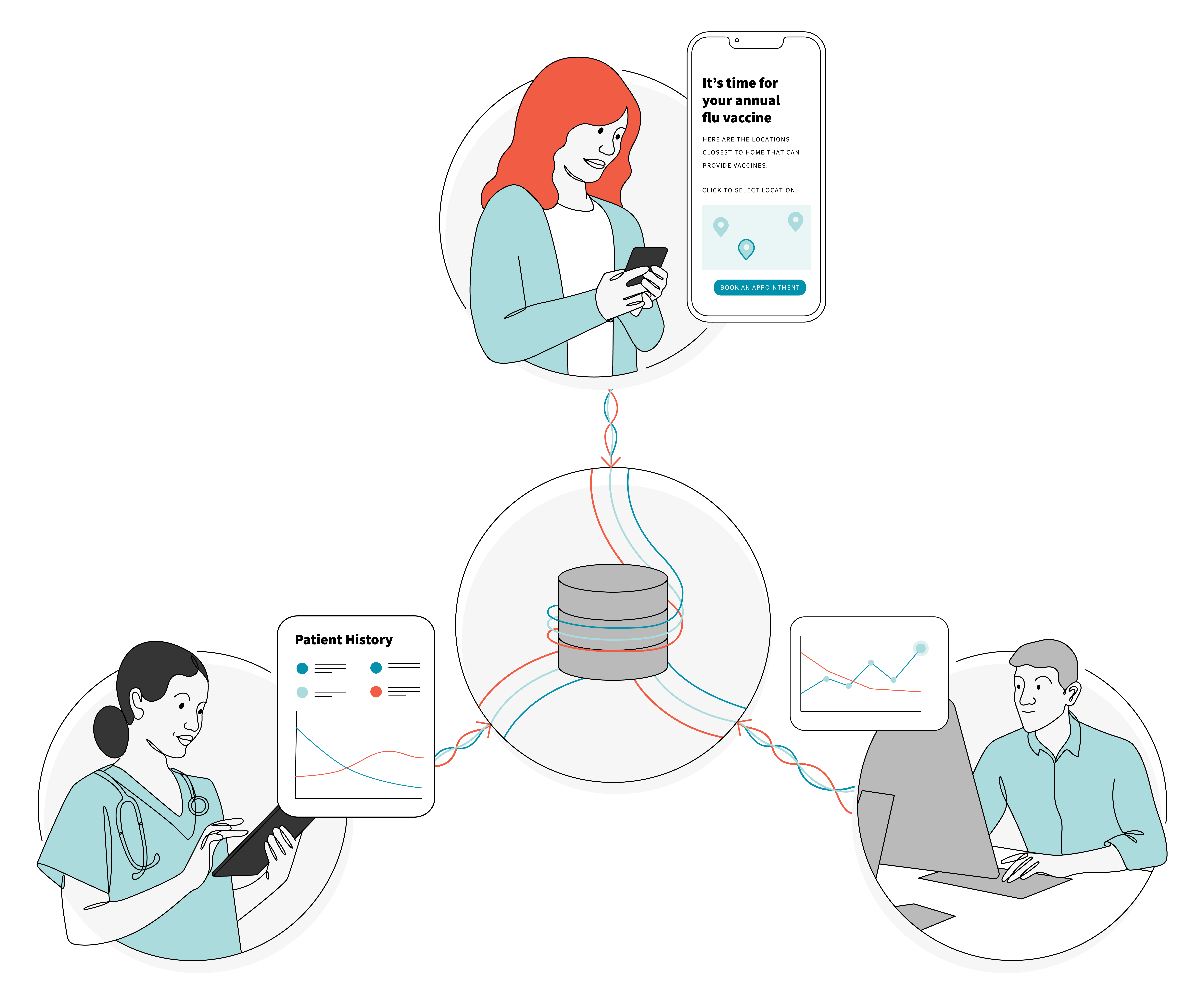
This layer directs data flow to and from the EHR and the patient-facing application. For patients, this will result in a unified and simpler experience as well as offer the proactive and personalized nudges that patients seek. For providers, this will help them manage their patients outside clinical settings in a scalable way. It allows the EHR to do what it does best—serve as the source of truth.
STARTING THE OPERATION
Redesigning healthcare models is a tremendous and exciting task, one that requires vision and commitment. What’s needed to make this happen is a maverick healthcare leader, paired with a sufficiently capable partner, from strategy to execution. The question is: Are you ready to put the operation in motion? If so, let’s chat.
Illustrations by Jillian King


